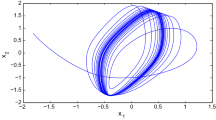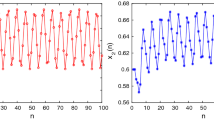Abstract
This paper focuses on the challenge of fixed-time control for spatiotemporal neural networks (SNNs) with discontinuous activations and time-varying coefficients. A novel fixed-time convergence lemma is proposed, which facilitates the handling of time-varying coefficients of SNNs and relaxes the restriction on the non-positive definiteness of the derivative of the Lyapunov function. Besides, a more flexible and economical aperiodically switching control technique is presented to stabilize SNNs within a fixed time, effectively reducing the amount of information transmission and control costs. Under the newly established fixed-time convergence lemma and aperiodically switching controller, many more general algebraic conditions are deduced to ensure the fixed-time stabilization of SNNs. Numerical examples are provided to manifest the validity of the results.
Similar content being viewed by others
References
Alharthi M R, Marchant T R, Nelson M I. Mixed quadratic-cubic autocatalytic reaction-diffusion equations: semi-analytical solutions. Appl Math Model, 2014, 38: 5160–5173
Alfifi H Y. Semi-analytical solutions for the delayed and diffusive viral infection model with logistic growth. J Nonlinear Sci Appl, 2019, 12: 589–601
Noufaey K S A, Marchant T R, Edwards M P. The diffusive Lotka-Volterra predator-prey system with delay. Math Biosci, 2015, 270: 30–40
Zhang R, Zeng D, Park J H, et al. Fuzzy adaptive event-triggered sampled-data control for stabilization of T-S fuzzy memristive neural networks with reaction-diffusion terms. IEEE Trans Fuzzy Syst, 2020, 29: 1775–1785
Yang C D, Cao J D, Huang T W, et al. Guaranteed cost boundary control for cluster synchronization of complex spatiotemporal dynamical networks with community structure. Sci China Inf Sci, 2018, 61: 052203
Liao X, Fu Y, Gao J, et al. Stability of Hopfield neural networks with reaction-diffusion terms (in Chinese). Acta Electronica Sin, 2000, 28: 78–80
Chen W H, Luo S, Zheng W X. Impulsive synchronization of reaction-diffusion neural networks with mixed delays and its application to image encryption. IEEE Trans Neural Netw Learn Syst, 2016, 27: 2696–2710
Wei T, Lin P, Wang Y, et al. Stability of stochastic impulsive reaction-diffusion neural networks with S-type distributed delays and its application to image encryption. Neural Networks, 2019, 116: 35–45
Wang L, Zeng Z, Ge M F. A disturbance rejection framework for finite-time and fixed-time stabilization of delayed memristive neural networks. IEEE Trans Syst Man Cybern Syst, 2021, 51: 905–915
Wang J, Wang X, Xie N, et al. Fuzzy-model-based \(\cal{H}_{\infty}\) pinning synchronization for coupled neural networks subject to reaction-diffusion. IEEE Trans Fuzzy Syst, 2020, 30: 248–257
Zhang H, Zeng Z. Adaptive synchronization of reaction-diffusion neural networks with nondifferentiable delay via state coupling and spatial coupling. IEEE Trans Neural Netw Learn Syst, 2022. doi: https://doi.org/10.1109/TNNLS.2022.3144222
Zhang H, Zeng Z. Stability and synchronization of nonautonomous reaction-diffusion neural networks with general time-varying delays. IEEE Trans Neural Netw Learn Syst, 2022, 33: 5804–5817
Yang X, Cao J. Exponential synchronization of delayed neural networks with discontinuous activations. IEEE Trans Circuits Syst I, 2013, 60: 2431–2439
Forti M, Nistri P. Global convergence of neural networks with discontinuous neuron activations. IEEE Trans Circuits Syst I, 2003, 50: 1421–1435
Hu C, Yu J, Chen Z, et al. Fixed-time stability of dynamical systems and fixed-time synchronization of coupled discontinuous neural networks. Neural Networks, 2017, 89: 74–83
Forti M, Nistri P, Papini D. Global exponential stability and global convergence in finite time of delayed neural networks with infinite gain. IEEE Trans Neural Netw, 2005, 16: 1449–1463
Hong H F, Wang H, Wang Z L, et al. Finite-time and fixed-time consensus problems for second-order multi-agent systems with reduced state information. Sci China Inf Sci, 2019, 62: 212201
Zhang L J, Xia Y Q, Shen G H, et al. Fixed-time attitude tracking control for spacecraft based on a fixed-time extended state observer. Sci China Inf Sci, 2021, 64: 212201
Xie X, Zhou Q, Yue D, et al. Relaxed control design of discrete-time Takagi-Sugeno fuzzy systems: an event-triggered real-time scheduling approach. IEEE Trans Syst Man Cybern Syst, 2017, 48: 2251–2262
Li H, Wang L, Lai Q. Synchronization of a memristor chaotic system and image encryption. Int J Bifurcation Chaos, 2021, 31: 2150251
Song X, Man J, Ahn C K, et al. Synchronization in finite/fixed time for Markovian complex-valued nonlinear interconnected neural networks with reaction-diffusion terms. IEEE Trans Netw Sci Eng, 2021, 8: 3313–3324
Wei R, Cao J, Kurths J. Fixed-time output synchronization of coupled reaction-diffusion neural networks with delayed output couplings. IEEE Trans Netw Sci Eng, 2021, 8: 780–789
Wang Z, Cao J, Cai Z, et al. Anti-synchronization in fixed time for discontinuous reaction-diffusion neural networks with time-varying coefficients and time delay. IEEE Trans Cybern, 2019, 50: 2758–2769
Liu B, Yang M, Liu T, et al. Stabilization to exponential input-to-state stability via aperiodic intermittent control. IEEE Trans Automat Contr, 2020, 66: 2913–2919
Tang R, Su H, Zou Y, et al. Finite-time synchronization of Markovian coupled neural networks with delays via intermittent quantized control: linear programming approach. IEEE Trans Neural Netw Learn Syst, 2022, 33: 5268–5278
Gan Q, Xiao F, Sheng H. Fixed-time outer synchronization of hybrid-coupled delayed complex networks via periodically semi-intermittent control. J Franklin Institute, 2019, 356: 6656–6677
Cheng L, Tang F, Shi X, et al. Finite-time and fixed-time synchronization of delayed memristive neural networks via adaptive aperiodically intermittent adjustment strategy. IEEE Trans Neural Netw Learn Syst, 2022. doi: https://doi.org/10.1109/TNNLS.2022.3151478
Mei J, Jiang M H, Wang X H, et al. Finite-time synchronization of drive-response systems via periodically intermittent adaptive control. J Franklin Institute, 2014, 351: 2691–2710
Zhang S, Yang Y, Sui X, et al. Finite-time synchronization of memristive neural networks with parameter uncertainties via aperiodically intermittent adjustment. Phys A-Stat Mech its Appl, 2019, 534: 122258
Cai Z, Huang L, Wang Z. Finite-/fixed-time stability of nonautonomous functional differential inclusion: Lyapunov approach involving indefinite derivative. IEEE Trans Neural Netw Learn Syst, 2022, 33: 6763–6774
Song X, Man J, Song S, et al. Finite/fixed-time anti-synchronization of inconsistent markovian quaternion-valued memristive neural networks with reaction-diffusion terms. IEEE Trans Circuits Syst I, 2020, 68: 363–375
Wang Z, Cao J, Lu G, et al. Fixed-time passification analysis of interconnected memristive reaction-diffusion neural networks. IEEE Trans Netw Sci Eng, 2019, 7: 1814–1824
Wang J L, Zhang X X, Wu H N, et al. Finite-time passivity and synchronization of coupled reaction-diffusion neural networks with multiple weights. IEEE Trans Cybern, 2018, 49: 3385–3397
Qiu Q, Su H. Finite-time output synchronization for output-coupled reaction-diffusion neural networks with directed topology. IEEE Trans Netw Sci Eng, 2022, 9: 1386–1394
Wang L, He H, Zeng Z. Global synchronization of fuzzy memristive neural networks with discrete and distributed delays. IEEE Trans Fuzzy Syst, 2020, 28: 2022–2034
Shanmugam L, Mani P, Rajan R, et al. Adaptive synchronization of reaction-diffusion neural networks and its application to secure communication. IEEE Trans Cybern, 2018, 50: 911–922
Ma Q, Feng G, Xu S. Delay-dependent stability criteria for reaction-diffusion neural networks with time-varying delays. IEEE Trans Cybern, 2013, 43: 1913–1920
Qiu Q, Su H. Sampling-based event-triggered exponential synchronization for reaction-diffusion neural networks. IEEE Trans Neural Netw Learn Syst, 2023, 34: 1209–1217
Zhang R, Zeng D, Park J H, et al. Adaptive event-triggered synchronization of reaction-diffusion neural networks. IEEE Trans Neural Netw Learn Syst, 2020, 32: 3723–3735
Allegretto W, Papini D. Stability for delayed reaction-diffusion neural networks. Phys Lett A, 2007, 360: 669–680
Frigon M. On a critical point theory for multivalued functionals and application to partial differential inclusions. Nonlinear Anal-Theor Methods Appl, 1998, 31: 735–753
Hu C, Jiang H J, Teng Z D. Impulsive control and synchronization for delayed neural networks with reaction-diffusion terms. IEEE Trans Neural Netw, 2010, 21: 67–81
Forti M, Grazzini M, Nistri P, et al. Generalized Lyapunov approach for convergence of neural networks with discontinuous or non-Lipschitz activations. Phys D-Nonlinear Phenom, 2006, 214: 88–99
Wang L, Zeng K, Hu C, et al. Multiple finite-time synchronization of delayed inertial neural networks via a unified control scheme. Knowledge-Based Syst, 2022, 236: 107785
Cai Z, Huang L. Generalized Lyapunov approach for functional differential inclusions. Automatica, 2020, 113: 10874
Acknowledgements
This work was supported by National Natural Science Foundation of China (Grant No. 62076229).
Author information
Authors and Affiliations
Corresponding author
Rights and permissions
About this article
Cite this article
Hu, X., Wang, L., Zhang, CK. et al. Fixed-time stabilization of discontinuous spatiotemporal neural networks with time-varying coefficients via aperiodically switching control. Sci. China Inf. Sci. 66, 152204 (2023). https://doi.org/10.1007/s11432-022-3633-9
Received:
Revised:
Accepted:
Published:
DOI: https://doi.org/10.1007/s11432-022-3633-9




